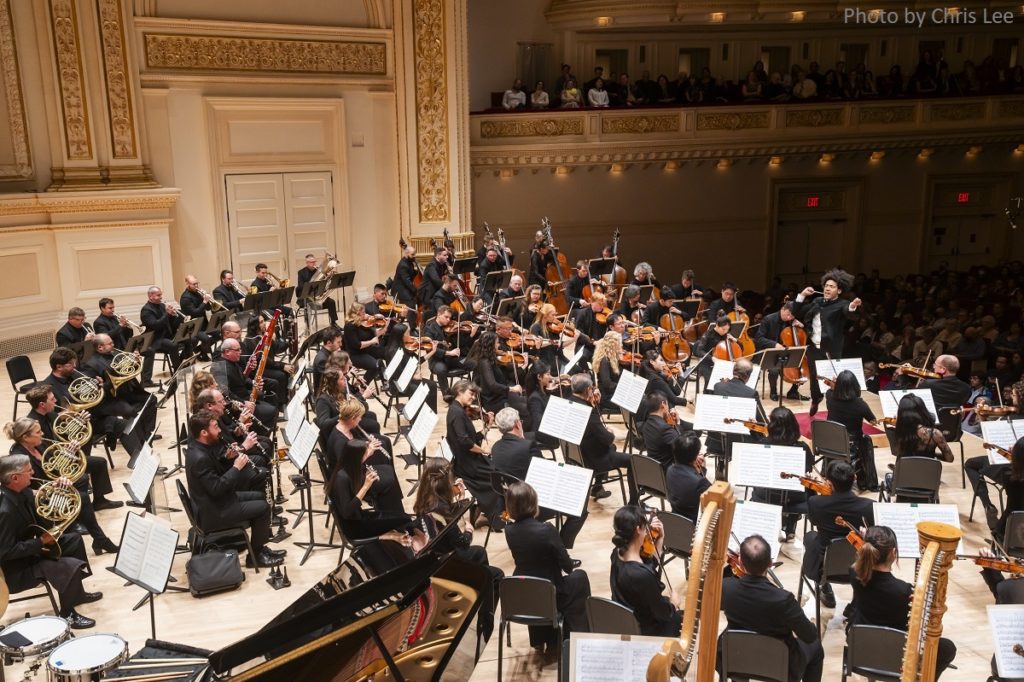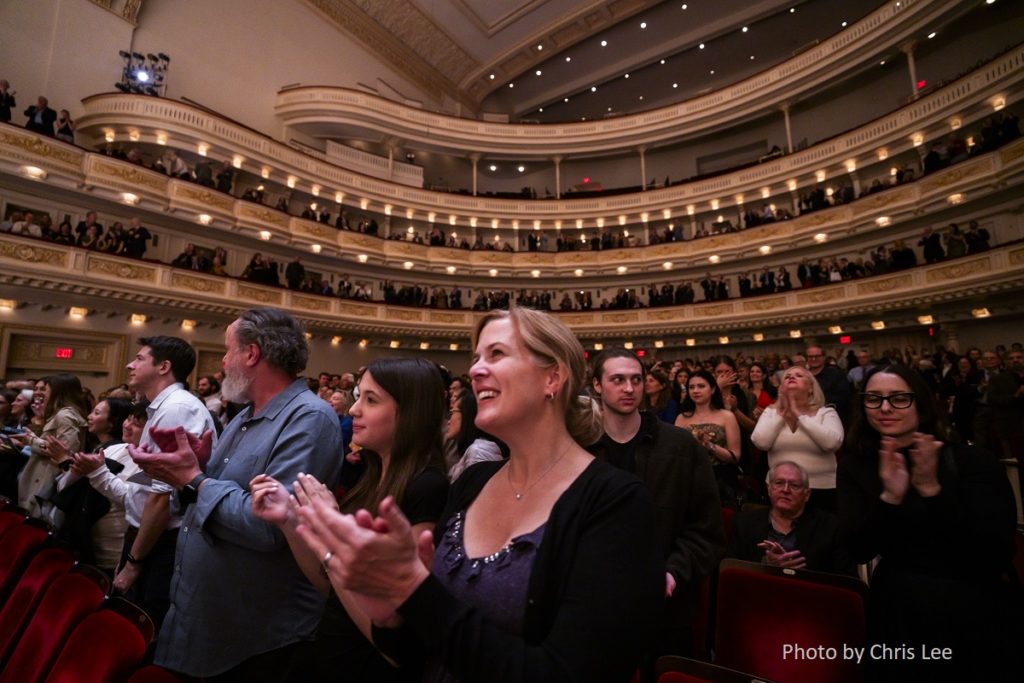America’s Finest City Makes a Statement in the Big Apple

by Rodion Belousov, second oboe
In October 2023, the San Diego Symphony, under the guidance of its esteemed music director, Rafael Payare, embarked on a journey to New York – our first out-of-state tour since COVID-19. It was a grand and glorious event that marked a distinguished milestone in the history of the San Diego Symphony.
From the moment the orchestra received the exciting news about the tour approximately a year ago, anticipation and excitement had been simmering. Finally, the long-anticipated day arrived, and it was time to travel to New York. It was a beautiful Wednesday morning when the orchestra gathered at the San Diego airport with their instruments. For those who’ve never traveled with a musical instrument, it is not an easy task. As an oboe player, I consider myself “somewhat” lucky as my instrument is quite compact and fits nicely into the plane’s overhead compartment. However, my fortune is tempered by the necessity to check a significant portion of my essential equipment. This essential equipment I’m referring to comprises an array of tools, including various types of knives, sharpening stones, razor blades, cutting blocks, and more, all crucial for reedmaking – the process of manufacturing oboe reeds.
Cellists and tuba players, unfortunately, face a different set of challenges when it comes to air travel, as their instruments are far too large to fit into the overhead bins or under the seats. As a result, they must purchase an extra seat solely for their instruments. The sight of a cellist or tuba player cautiously navigating the narrow aisles of an airplane with their large instrument on their back is one that will surely leave a lasting impression. However, it’s heartening to note that many fellow passengers often display great consideration and willingness to exchange seats, if needed, to facilitate easier access for musicians to their instruments. This gesture of kindness is something we, as musicians, are always immensely grateful for.
As we approached New York, the familiar East Coast autumn gloom welcomed us with open arms. Despite the late hour of our arrival, the city was bustling with activity, full of people conversing, laughing, and occasionally yelling. It was a vibrant scene, with folks donning superhero costumes, clad in their favorite sports jerseys, and elegantly dressed in suits with fedoras, all contributing to the unique tapestry of the city. And, of course, there was that distinct smell of street food coming from the food trucks stationed on every street corner of Manhattan.
Before gracing the legendary stage of Carnegie Hall, the orchestra had another performance lined up at Lehigh University in Bethlehem, Pennsylvania the night before. This private research university was about a two-hour drive from New York City. In stark contrast to the bustling energy of New York, the city of Bethlehem was a quaint and charming college town. Our first order of business involved conducting a thorough soundcheck to acquaint ourselves with the acoustics of the hall and make any necessary adjustments. After having spent so much time rehearsing and performing outdoors at the Rady Shell, it was crucial for the orchestra to “feel” the hall and attune itself to its unique demands. The acoustics were gradually sculpted and refined, until every note resonated with absolute clarity and precision. The musicians played with confidence, knowing that their artistry would be faithfully conveyed to the audience.
The concert’s program offered a sneak peek into the repertoire that the San Diego Symphony was set to perform at Carnegie Hall the following evening, including the East Coast Premiere of “Wake Up,” a piece by Carlos Simon, co-commissioned by the San Diego Symphony and the National Symphony, as well as Shostakovich’s Symphony No. 5, and Dvorak’s Cello Concerto, featuring the virtuoso soloist Alisa Weilerstein. With the initial words of gratitude and a proper introduction dissolving into an expectant hush, the concert officially commenced. It was an immensely gratifying experience for both the orchestra and the audience, as we embarked on a collective journey through diverse musical landscapes, ultimately culminating in a roaring eruption of sound that was Shostakovich’s Fifth Symphony.
As the final note dissipated into the ether, the audience burst into a thunderous applause. Rafael acknowledged the appreciation with a profound bow, his humility evident in his every gesture. He had given his all, poured his heart and soul into the performance, and the audience responded with fervent enthusiasm. With a smile, he turned to the orchestra, offering us a nod of gratitude.
And so the day had arrived. As I woke up, my heart was racing with excitement. The prospect of performing at Carnegie Hall was a mix of both exhilaration and trepidation. The venue’s rich history and unparalleled prestige were enough to quicken the pulse of anyone fortunate enough to perform on its hallowed stage. Yet, it was precisely this excitement that would empower the San Diego Symphony to deliver a performance of a lifetime. As the concert’s hour drew near and the musicians took their places on stage, instruments poised and ready, I could just see how many people came to the concert. Some were familiar faces, some were total strangers, but what truly caught my attention was the abundance of youthful audience members scattered throughout the auditorium. With their eager eyes sparkling with anticipation, they were ready to become a part of this transformative experience. The first notes of the music filled the hall, cascading over the audience like a sonorous wave. The members of the San Diego Symphony played with unwavering passion and intensity, their instruments blending together in perfect harmony. The music itself was both powerful and moving, stirring the hearts of those in attendance. It spoke in a universal language, one that transcended words and rivetingly conveyed deep emotions. It was a shared experience that brought everyone together with a sense of community and belonging. All due credit must be given to every musician who performed that day. Their mastery and virtuosity that evening were nothing short of awe-inspiring.
The concert proved to be a resounding success and a compelling testament to the dedication and artistry of the San Diego Symphony. As the final note reverberated and the audience erupted in jubilant cheers, for a moment I found myself overwhelmed. A profound sense of exhaustion washed over me, but it was intertwined with an equally profound sense of fulfillment. I looked around and saw similar expressions on the faces of my colleagues – everyone was beaming. The journey leading up to this evening had been demanding, marked by countless hours of practice and commitment and, in this fleeting instance, it all felt worth it.
While this wasn’t my first time performing at Carnegie Hall, stepping onto its stage is always brand new and always a dream come true. It is a validation of the countless years of hard work and dedication. Moreover, it is a reminder of the power of music in stirring and inspiring the human spirit. I am extremely grateful for this invaluable opportunity to have performed in such a prestigious venue, and I will cherish the memory of that unforgettable night for the rest of my life.

